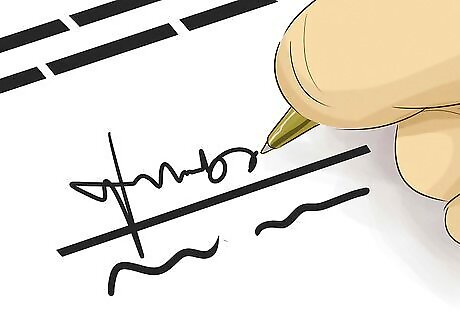
views
Preparing Your Case

Decide who you are going to sue. Before you file a lawsuit, you need to know who you are going to sue. The person or business entity you sue must have caused harm to you, or have control or responsibility over the individual who did.

Determine your causes of action. You can file a federal lawsuit if some right of yours has been violated that arises from the federal Constitution, or from federal statutes or regulations. The first part of your complaint will deal with the fact that the person you want to sue harmed you in some way, and that the federal court has the power to order relief of that harm. For example, you might claim that someone has violated your civil rights. However, keep in mind that in many cases you must file a claim with a federal or state agency before you have the right to file a lawsuit in federal court. Certain types of cases, such as bankruptcy cases, are always heard in federal court. Others depend on the person who harmed you. If the federal government (or a federal employee) harmed you due to negligence, you would file in federal court because you have to sue the federal government in federal court. However, if your next door neighbor had injured you in the same way, you wouldn't be able to sue him in federal court, because the court wouldn't have jurisdiction over your claim. In addition to cases arising under federal law, federal courts also have diversity jurisdiction. Your cause of action arises under diversity jurisdiction if you are suing someone from another state and asking for at least $75,000 in money damages. Keep in mind that diversity jurisdiction isn't the same as personal jurisdiction, even though it depends on where the people in the case live. Diversity jurisdiction gives the court the power to hear the subject of the case. Even if the court has the power to hear what the case is about, it also must have power over the people involved in the suit. Personal jurisdiction has to do with the location of the court itself and whether the court has power over the person you're suing. For example, if you slip and fall on a banana peel while at a zoo in Georgia, it's probable that only courts in Georgia would have personal jurisdiction over that zoo. You can use the online court locator to find the court where you need to file your lawsuit.

Check the statute of limitations. This is the period of time you have to file a lawsuit under each law. If the statute of limitations has passed, you no longer have the right to file a lawsuit. These deadlines can change as a result of various actions. If you're not sure whether the statute of limitations has passed, or if you're getting close to the deadline, talk to an attorney to find out for sure before you file your lawsuit. Except if you're suing a government agency, the statute of limitations usually will be at least one year. When suing a government agency, you typically are required to file an administrative complaint with the agency first, sometimes in as little as 60 days after the incident occurred that gave rise to the complaint.

Evaluate the elements of your claims. Each claim you have can be made more simple by breaking it down into distinct elements. Doing so tells you what you have to prove if you want to win your case. For example, defamation is a legal claim in which someone either negligently or intentionally made a false statement of fact about you to a third party, causing you injury. If someone told your boss that you had been fired from your previous job for theft, even though you hadn't, you might have a claim for defamation against the person who spread that rumor, if you can prove he acted negligently or intentionally. To prove negligence or intention, you would have to demonstrate either that he knew the information was false, or that a reasonable person exercising due care could have discovered that the information was false.

Try to negotiate a compromise. Lawsuits, especially federal lawsuits, can be expensive, stressful, and time-consuming. Now that you've studied your claim, you have a better idea of how much it's worth. Consider writing up a settlement offer and sending it to the person or company you intend to sue. Don't be rude or threatening, but let them know that while you do intend to file a lawsuit, you think it would be much better on all accounts if the problem could be resolved outside of court.
Drafting Your Complaint

Consider hiring an attorney. Federal court procedure is fairly complicated, and if you represent yourself you will be expected to understand the rules of procedure and rules of evidence as well as any attorney. Even if you can't afford an attorney, you may be able to find someone who is willing to look over your paperwork and ensure it's correct, or guide you through the basic process, for a lesser fee. You also might check legal aid societies in your area or law school clinics, if you have a law school nearby.

Find prepared forms online. If you look on the website of the court where you need to file your lawsuit, or visit the clerk's office, you may be able to find prepared forms that you can adapt to suit your needs. The clerk's office can tell you about that court's particular formatting requirements, which may vary somewhat from court to court, and also let you know precisely what papers you need to file to start a civil action in that court. If you can't find prepared forms you can use, you can look up the pleadings from another case filed in the same court and use them as a guide. You also can read Rule 8 of the Federal Rules of Civil Procedure, which lists the basic elements of a federal complaint.

Create your caption. The caption lists the parties to the case, the case number (which you'll be assigned once you file your complaint), and the court where the case is being heard. Your caption will be the same for every document you file in that case. You should type "COMPLAINT" to the right of your caption. This tells the court what kind of document it is. If you want a jury trial, and your case is a kind of case that can be tried by jury, you should also type "JURY TRIAL DEMANDED" under the word "COMPLAINT" to the right of your caption.

Identify the parties. In numbered paragraphs, you should identify yourself, the defendant, and where each of you have residence. If the defendant is a business, its residency generally is defined by the state in which it was incorporated, where it has its main office, or where it is licensed to do business.

Define the court's jurisdiction. After you introduce the parties to the case, you should state up front how the court has the power to hear the case. For example, if your claim arises under the Federal Tort Claims Act, you would state that you are invoking the court's jurisdiction pursuant to that statute.

State your claims. In the rest of your complaint, state the facts upon which you are basing your claims using clear and concise language. Attach exhibits, if necessary. For example, if you mention that you and the defendant signed a contract, you should attach a copy of that contract so the court can review it.

List your damages. After you've stated all the ways in which you were harmed by the defendant, tell the court what money or other damages you are asking for to compensate for your injuries.

Create signature blocks. Finish your complaint by dropping down a few lines to create a space for your signature. Type a solid line, then type your name, address, and phone number underneath.

Fill out a summons for each defendant you've named. The summons tells the defendant that he has been sued in federal court, and how long he has to respond to the lawsuit. You can download a form for the summons at the U.S. Courts website.

Complete any other paperwork required to open a lawsuit. Each district may require other documents, such as a civil cover sheet, to accompany your complaint. Check with the clerk's office, or the court's website, to make sure you have all the correct forms before you proceed.
Filing Your Complaint

Sign your documents. Before you file your complaint, you must sign and date it. You may be required to sign in front of a notary public, so check your court's local rules beforehand. If you can't find a notary, there usually is one at the courthouse, but he may charge a fee for his services. Banks often provide notaries for their customers free of charge, so call your bank and see if it offers this service.

Assemble your complaint, exhibits, and other paperwork to make copies. You will need to bring your originals plus at least two copies to the courthouse to file. If you have more than one defendant, you must have a copy for each of them. Although you can make copies at the clerk's office, you may have to pay 15 cents a page to use the copiers there, so if you can make your copies more cheaply before you go to the courthouse, you should do so. Your type must be in black ink, and you must use white paper of 8-1/2 x 11 size.

File your paperwork with the clerk of court. If you are filing paper forms, you can file by mail, or in person during office hours. Your documents must be accompanied by a filing fee of $400. If you cannot afford the fee, you can file a motion to have the fee waived. The court clerk will stamp your originals and copies "filed" with the date, and give your case a number. The originals remain with the court, while the copies are returned to you to serve on the defendants.

Serve the defendants. Rule 4 of the Federal Rules of Civil Procedure governs how to properly serve the defendants in your lawsuit. Generally, the summons and a copy of your complaint may be served by anyone who is at least 18 years old and not a party in your case. After service, the server must submit an affidavit of service as proof to the court that defendants were served.

Wait for an answer. After the defendant has been served, he has 21 days to file an answer to your lawsuit in federal court. If he fails to respond, you may be awarded a default judgment.



















Comments
0 comment